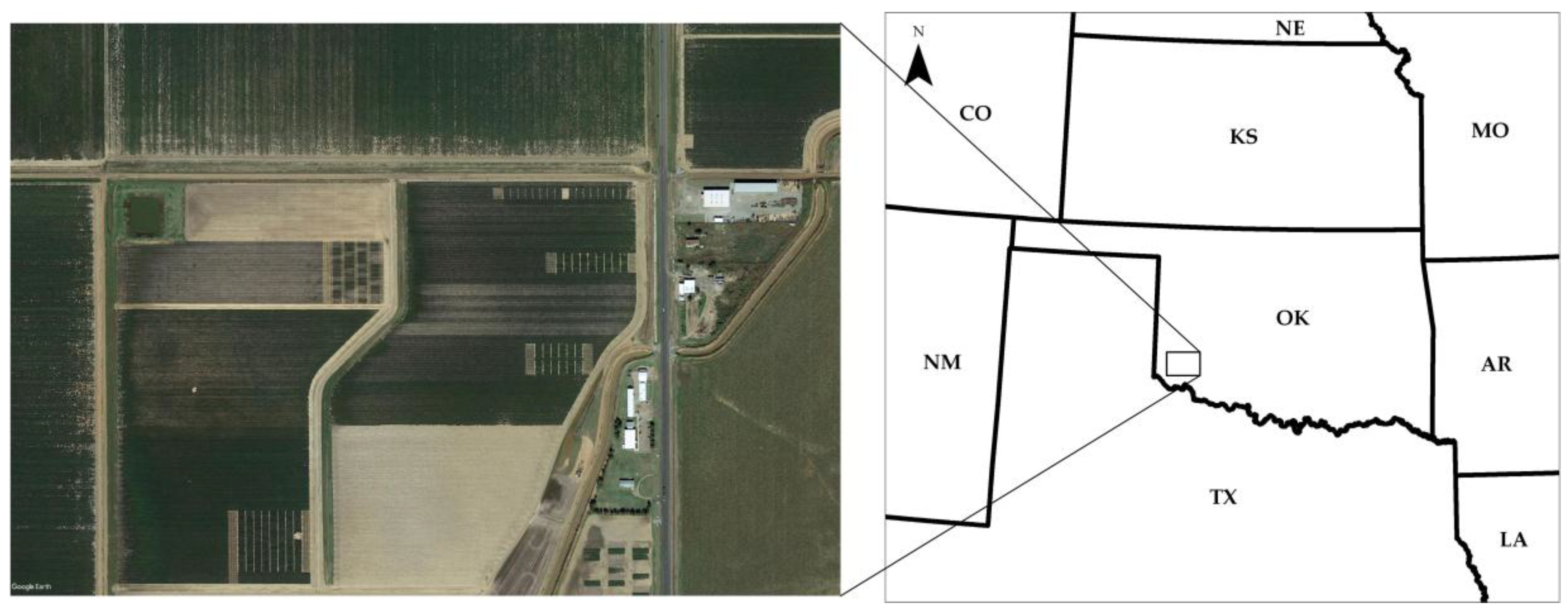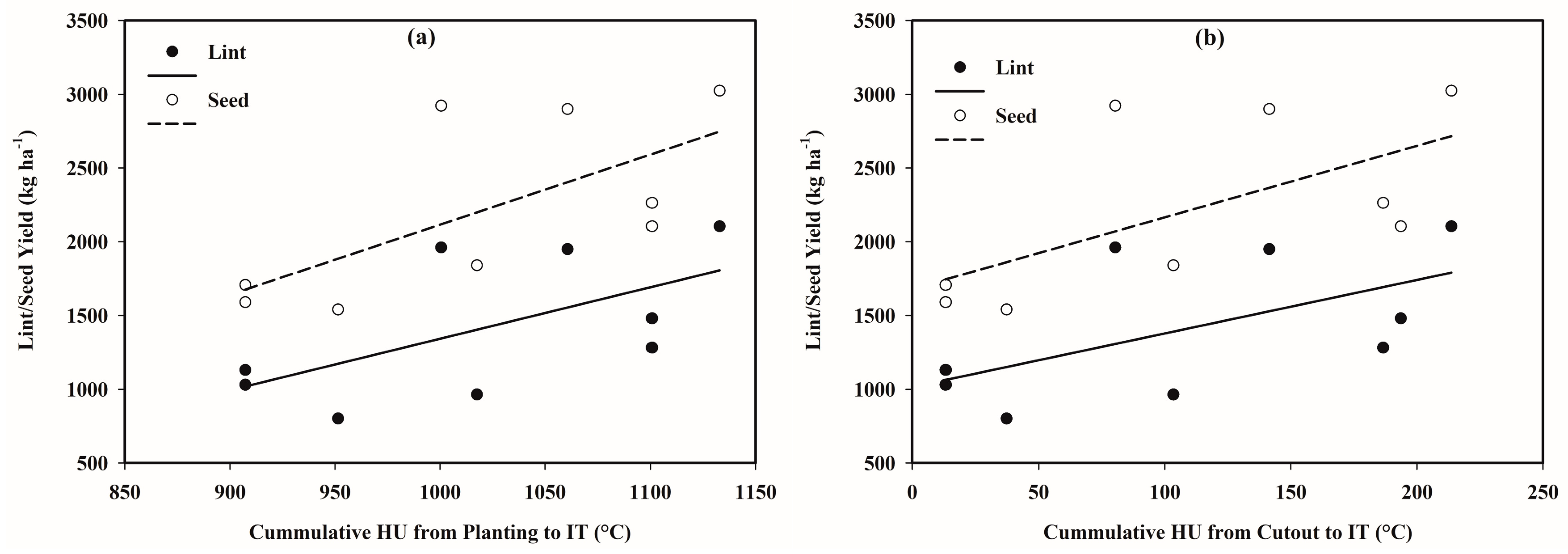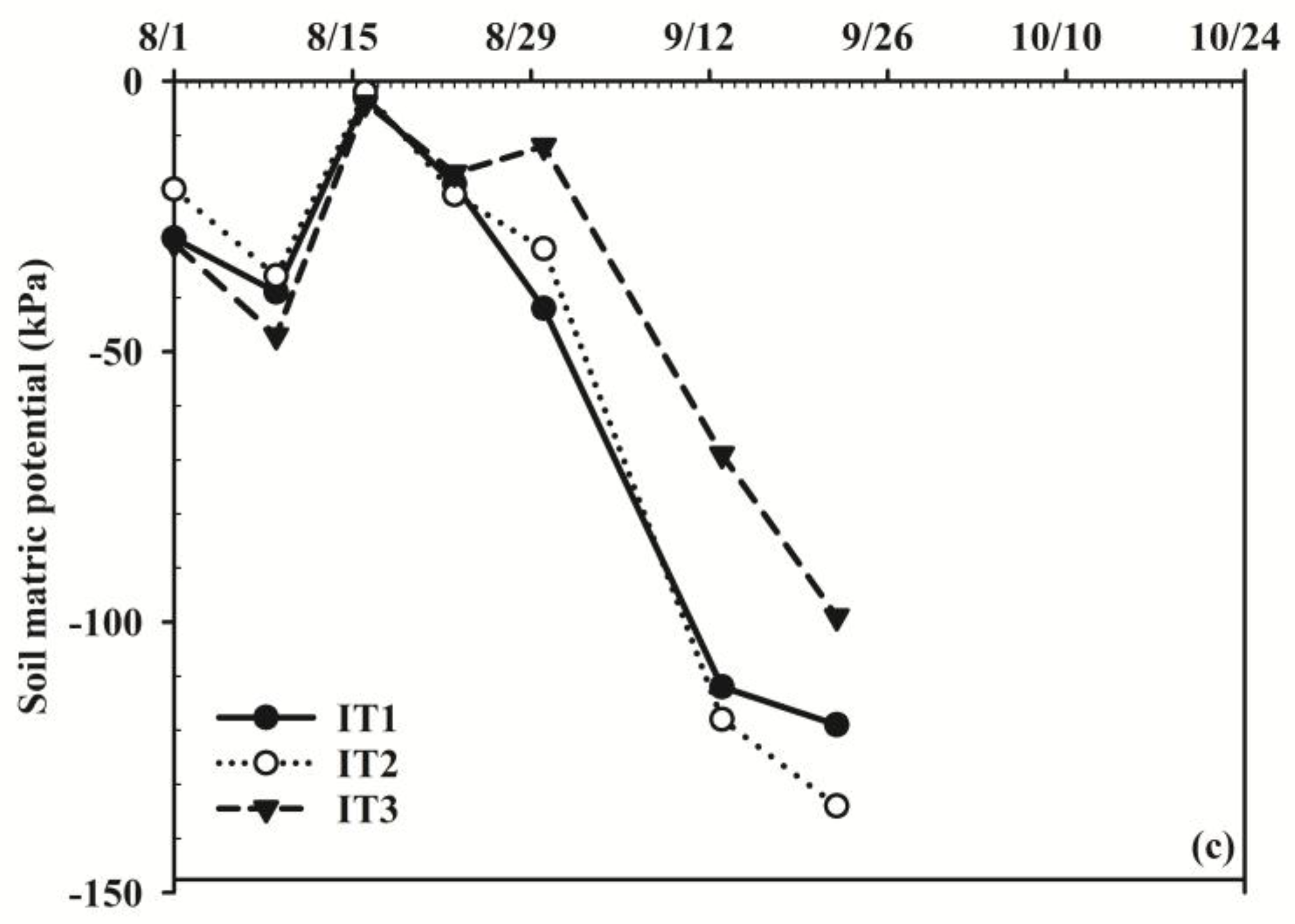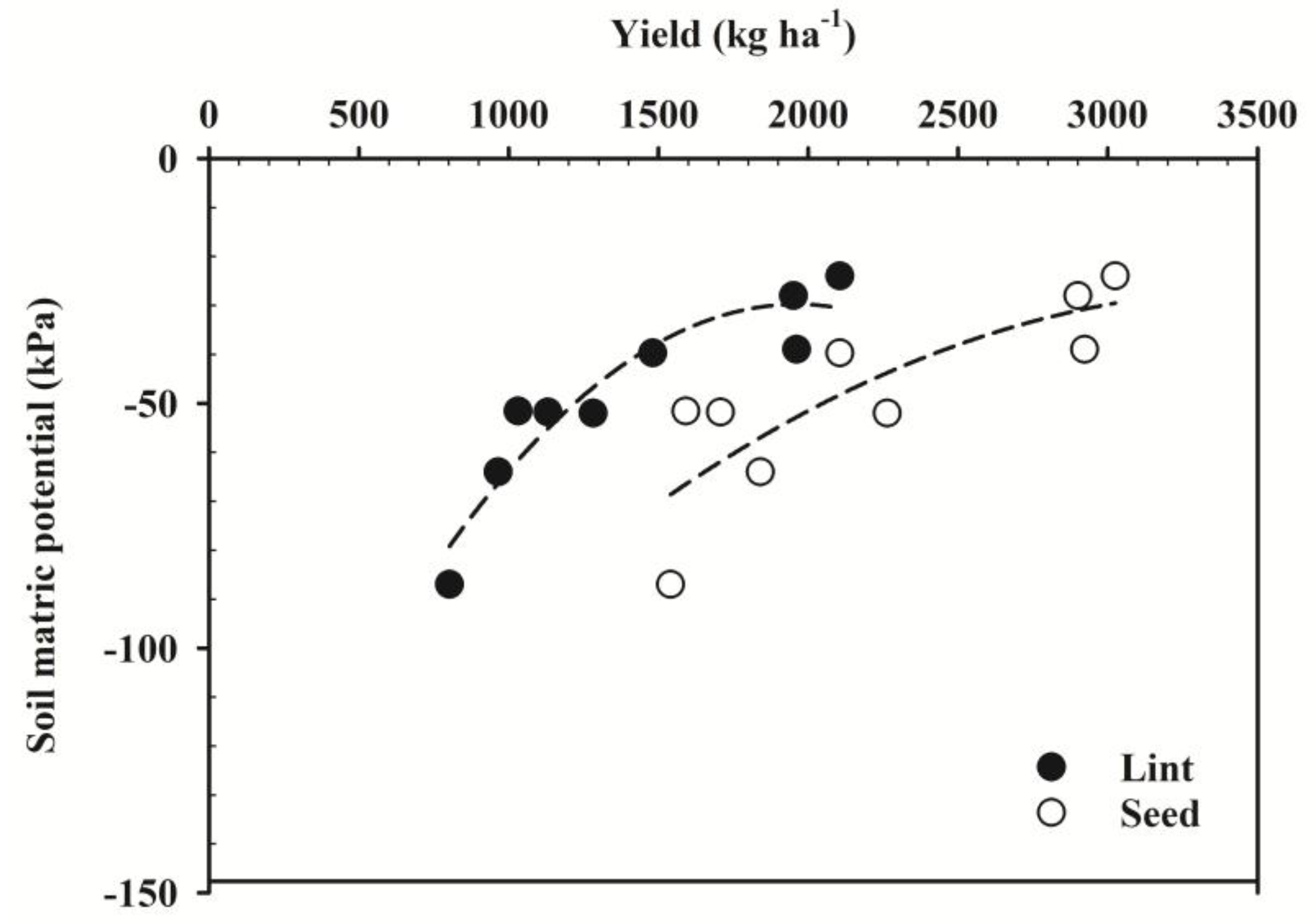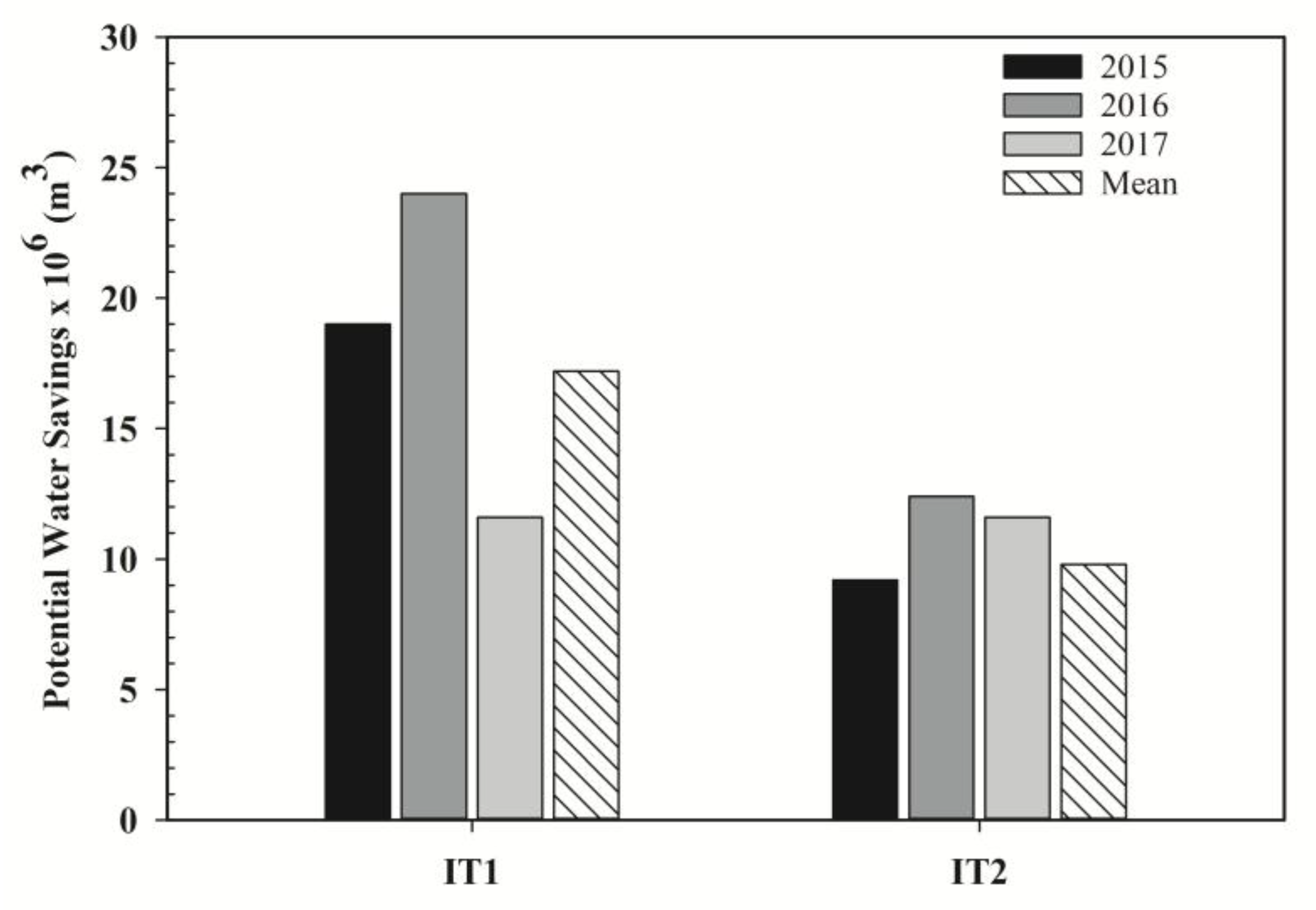1. Introduction
The United States (U.S.) is amongst the top cotton producers in the world, ranking third in production and first in exports [
1,
2]. Cotton is predominantly grown in the cotton belt region of the U.S., mostly in states below the 37° N latitude [
3]. Among these, Oklahoma has been consistently listed as one of the leading cotton producing states, ranking fifth for the year 2017 [
4]. Furthermore, cotton is the third most important field crop in Oklahoma and contributes significantly to the economy of this state [
5,
6]. More than 80% of cotton by area and production is cultivated in Southwest Oklahoma [
7]. Due to the semi-arid climate of this region, irrigation plays an important role in sustaining the production and enhancing the market value of cotton [
8].
Irrigation water resources in southwest Oklahoma are scarce due to several reasons. First, many local surface and groundwater resources have poor quality caused by dense salt deposits [
9]. Osborn and Hardy [
10] reported total dissolved solids (TDS) in the range of 1500 to 5000 mg L
−1 in the Blaine aquifer, one of the major aquifers in the region. The critical TDS of irrigation water for cotton production is 3264 mg L
−1, above which yield starts to decline [
11]. The high salt levels found in irrigation water resources in southwest Oklahoma mostly originate from the abundant thick gypsum beds that have a high concentration of calcium and sulfate. These geological features have affected local rivers that supply most of the surface water resources in the region. For instance, Mittelstet et al. [
9] reported heavy contamination of the North Fork of the Red River as water flows through salt deposits via its tributaries.
In addition to these water quality challenges, southwest Oklahoma has suffered severe droughts in recent years, and this has affected surface water availability [
12]. The latest drought that occurred from 2010 to 2015 led to a significant decline of water level in Lake Altus-Lugert, which supplies the Lugert Altus Irrigation District (LAID), the largest irrigation district in southwest Oklahoma [
13]. This water level decline resulted in the failure to release irrigation water from the lake since the water level had dropped below the intake to the main canal [
13]. Consequently, cotton production experienced all-time low records during this period, with devastating impacts on the local economy. Moreover, water demand in the Lake Altus-Lugert catchment has been projected to increase by approximately 70 percent by 2060. Based on this forecast, southwest Oklahoma has been listed as a water resource “hot spot” in the state [
14]. Other cotton production areas in the region, such as in the Texas Panhandle, face similar water scarcity challenges [
15].
Considering the highlighted water resources issues in cotton production, it is imperative that producers employ irrigation practices that conserve water. Even though cotton has been reported to have relatively higher drought resistance and lower water requirement compared to other field crops [
3], more ways to reduce cotton irrigation demand should be investigated. One approach is through optimizing the time of irrigation termination (IT), an important factor in cotton irrigation management that can boost crop maturity by accelerating boll opening, reducing boll rotting, and facilitating defoliation by inhibiting vegetative overgrowth [
16,
17,
18].
Reba et al. [
19] reported that water conservation could be realized following a precision IT based on growth stages and weather conditions without negatively affecting cotton lint yield. However, several studies have shown divergent views regarding the earliness of cotton IT without causing yield and quality losses. Monge [
20] and Vories et al. [
21] determined an optimal IT time of approximately 200-degree days (15.6 °C base temperature) after physiological cutout. They argued that irrigation beyond this point added neither yield nor profit. Conversely, Hogan [
22] estimated an optimal IT time at 306-degree days after cutout and Buttar et al. [
23] showed significant cotton yield increases with later IT. In another study where IT treatments ranged from two to six weeks after physiological cutout, Reeves [
18] found contradictory results in different years. Cotton fiber quality improved in the later treatment in one year and the earlier treatment in another year. In the study by Karam et al. [
17], termination at first open boll achieved higher yields compared to later termination treatments.
These variable results demonstrate the need to further investigate the effects of irrigation termination on cotton yield. This is also evident and in support of the study by Lascano et al. [
24], who argued that even though there is an abundance of data on cotton yield response to the amount and timing of irrigation, very little information is available pertaining to the impact of irrigation termination timing on cotton yield and fiber quality. Vories et al. [
21] made the same observation, particularly for the U.S. Mid-South region, and highlighted that more research on cotton IT could help improve management practices by cotton producers, and more importantly complement water conservation efforts in arid and semi-arid regions. The goal of this research was to evaluate the effects of variable irrigation termination timings on the quantity and quality of cotton yield in southwest Oklahoma. The more specific objectives were: (i) to determine the impact of three irrigation termination dates on cotton seed and lint yield, fiber quality, and irrigation requirement during three growing seasons; and, (ii) to explore the relationships between cotton yield and two key management parameters: heat units and end-of-season soil water content.
4. Conclusions
The effects of variable irrigation termination (IT) dates on cotton yield, fiber quality and irrigation requirement were investigated in a field experiment in southwest Oklahoma during three growing seasons. Three weekly-spaced IT treatments were implemented in each year, with IT1 and IT3 treatments representing the earliest and the latest termination dates, respectively. The results showed a general increase in cotton yield with delaying of irrigation termination. However, the magnitude and statistical significance of this increase were largely dependent on the amount and distribution of late-season rainfall. A season characterized by hot and dry conditions during the months of August and September resulted in lint and seed yields that were significantly different amongst the IT treatments, whereas no difference was observed during a season with above normal rainfall. When averaged over the three seasons, lint yields were significantly different among all treatments. Seed yields for IT1 and IT2 were both similar to each other and significantly smaller than the yield of IT3. Late-season rainfall had a similar impact on fiber quality. On average, micronaire, uniformity, and strength were significantly impacted by IT treatments.
The relationships between cotton yield parameters and heat units accumulated from planting to IT and from physiological cutout to IT were positive, but weak and not significant, except in case of the seed yield and heat units from planting to IT. In contrast, strong positive relationships were found between cotton yield and root zone water content. The late-season soil matric potential can be monitored in the cotton root zone using soil moisture sensors and then used as a practical decision-making tool in optimizing IT management. When benchmarked against the latest IT treatment (IT3), the earlier treatments of IT1 and IT2 resulted in 28 and 16% reductions in applied irrigation amounts on average. However, these reductions were accompanied with similar percentages of declines in lint yield and value. Seed yield and micronaire were also impacted negatively, along with smaller declines in fiber length, uniformity, and strength. Additional research is needed to investigate the economic trade-offs between revenue losses from declined lint value and reductions in water and energy expenses when implementing earlier irrigation termination. Assuming all cotton producers within the major irrigation district in southwest Oklahoma adopt earlier IT practices, an average water savings of 17.2 and 9.8 million m3 can be achieved on a seasonal basis for IT1 and IT2 treatments, respectively. Future research should utilize long-term weather data in conjunction with additional tools such as crop growth models to further evaluate the effects of variable IT scenarios.
